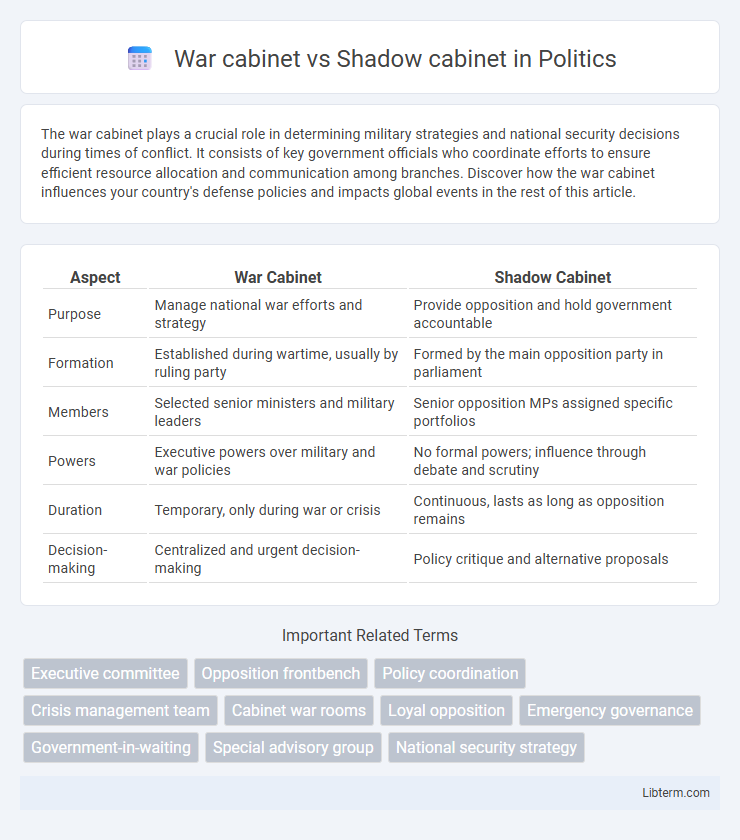The war cabinet plays a crucial role in determining military strategies and national security decisions during times of conflict. It consists of key government officials who coordinate efforts to ensure efficient resource allocation and communication among branches. Discover how the war cabinet influences your country's defense policies and impacts global events in the rest of this article.
Table of Comparison
| Aspect | War Cabinet | Shadow Cabinet |
|---|---|---|
| Purpose | Manage national war efforts and strategy | Provide opposition and hold government accountable |
| Formation | Established during wartime, usually by ruling party | Formed by the main opposition party in parliament |
| Members | Selected senior ministers and military leaders | Senior opposition MPs assigned specific portfolios |
| Powers | Executive powers over military and war policies | No formal powers; influence through debate and scrutiny |
| Duration | Temporary, only during war or crisis | Continuous, lasts as long as opposition remains |
| Decision-making | Centralized and urgent decision-making | Policy critique and alternative proposals |
Introduction: Defining War Cabinet and Shadow Cabinet
A War Cabinet is a specialized executive group formed during times of national crisis to make swift strategic decisions, often composed of key government ministers and military leaders. A Shadow Cabinet consists of senior members from the opposition party, tasked with scrutinizing and challenging the policies of the current government while presenting alternative policies. Both structures play crucial roles in parliamentary systems, with the War Cabinet focusing on crisis management and the Shadow Cabinet emphasizing political accountability.
Historical Evolution of War Cabinets
War cabinets emerged prominently during World War I and II as streamlined decision-making bodies designed to coordinate military strategy and national resources under emergency conditions. Unlike the broader shadow cabinets, which serve as opposition counterparts in parliamentary systems, war cabinets function with concentrated authority and reduced membership to enable rapid response. Their evolution reflects the shifting demands of total war, highlighting a trend toward centralized executive control in times of national crisis.
Origins and Development of Shadow Cabinets
The Shadow Cabinet originated in the British parliamentary system during the 19th century as an institutionalized group of senior opposition politicians mirroring the official Cabinet, designed to offer alternative policies and hold the government accountable. Its development evolved from informal opposition roles into a formalized structure that prepares the party for governance while scrutinizing the ruling administration. This concept has since been adopted by various parliamentary democracies, enhancing democratic oversight and fostering political readiness by continuously challenging government decisions.
Key Functions of a War Cabinet
The key functions of a War Cabinet include making critical, rapid decisions during times of national crisis or war, coordinating military strategies, and overseeing the allocation of resources to ensure effective defense efforts. It operates with a streamlined group of senior government officials and military leaders to maintain a unified command structure. The War Cabinet prioritizes national security, crisis management, and maintaining public morale through decisive leadership.
Primary Roles of the Shadow Cabinet
The primary roles of the Shadow Cabinet include scrutinizing government policies, offering alternative proposals, and holding the ruling party accountable in parliamentary systems. Each member of the Shadow Cabinet mirrors a specific government minister, enabling focused critique and policy development in their respective portfolios. This structure enhances democratic oversight by ensuring continuous debate and readiness to assume power if elected.
Composition and Membership Differences
The War Cabinet typically comprises a small, select group of senior government officials and military leaders directly involved in strategic wartime decision-making, often including the Prime Minister, Defence Secretary, and Chiefs of Staff. In contrast, the Shadow Cabinet consists of opposition party members who mirror official cabinet roles, with each Shadow Minister responsible for scrutinizing and challenging the policies of their government counterparts. Membership in the War Cabinet is limited and focused on efficiency during crisis, whereas the Shadow Cabinet is broader, structured to provide alternative governance options across all government departments.
Decision-Making Processes Compared
The War Cabinet operates with a highly centralized decision-making process, involving a small group of senior government officials focused on timely, strategic responses during crises or wartime. In contrast, the Shadow Cabinet's decision-making is more consultative and exploratory, serving as a team of opposition members who scrutinize government policies and propose alternatives. The War Cabinet prioritizes rapid, unified decisions critical for national security, while the Shadow Cabinet emphasizes policy development and political accountability through debate and critique.
Impact on National Policy and Governance
The War Cabinet, established during wartime, centralizes decision-making to swiftly coordinate military strategy and national resources, directly shaping defense and emergency policies. The Shadow Cabinet, as an opposition body in parliamentary systems, scrutinizes government actions and proposes alternative policies, influencing public debate and holding the ruling party accountable. Both structures impact governance by either streamlining crisis management or fostering democratic oversight and policy development.
War Cabinet vs Shadow Cabinet: Key Contrasts
War Cabinet vs Shadow Cabinet highlights critical governance distinctions during different political contexts. The War Cabinet, typically formed during national crises, comprises selected government members focused on urgent decision-making and wartime strategy, while the Shadow Cabinet consists of opposition party members tasked with scrutinizing government policies and presenting alternatives. These entities differ in purpose, authority, and operational scope, reflecting the dynamics of governance versus opposition roles.
Contemporary Relevance and Future Outlook
The war cabinet, characterized by its streamlined decision-making during crises, remains crucial for rapid government responses amidst global conflicts and emergencies, while shadow cabinets continue to hold significant relevance in democratic systems by providing accountability and alternative policy perspectives. Increasing geopolitical tensions and complex governance challenges emphasize the future importance of adaptable war cabinets to manage security threats efficiently, whereas shadow cabinets evolve with digital transparency and public engagement to strengthen opposition roles. Both structures are essential, with war cabinets addressing immediate national security needs and shadow cabinets fostering long-term political stability and democratic resilience.
War cabinet Infographic

 libterm.com
libterm.com